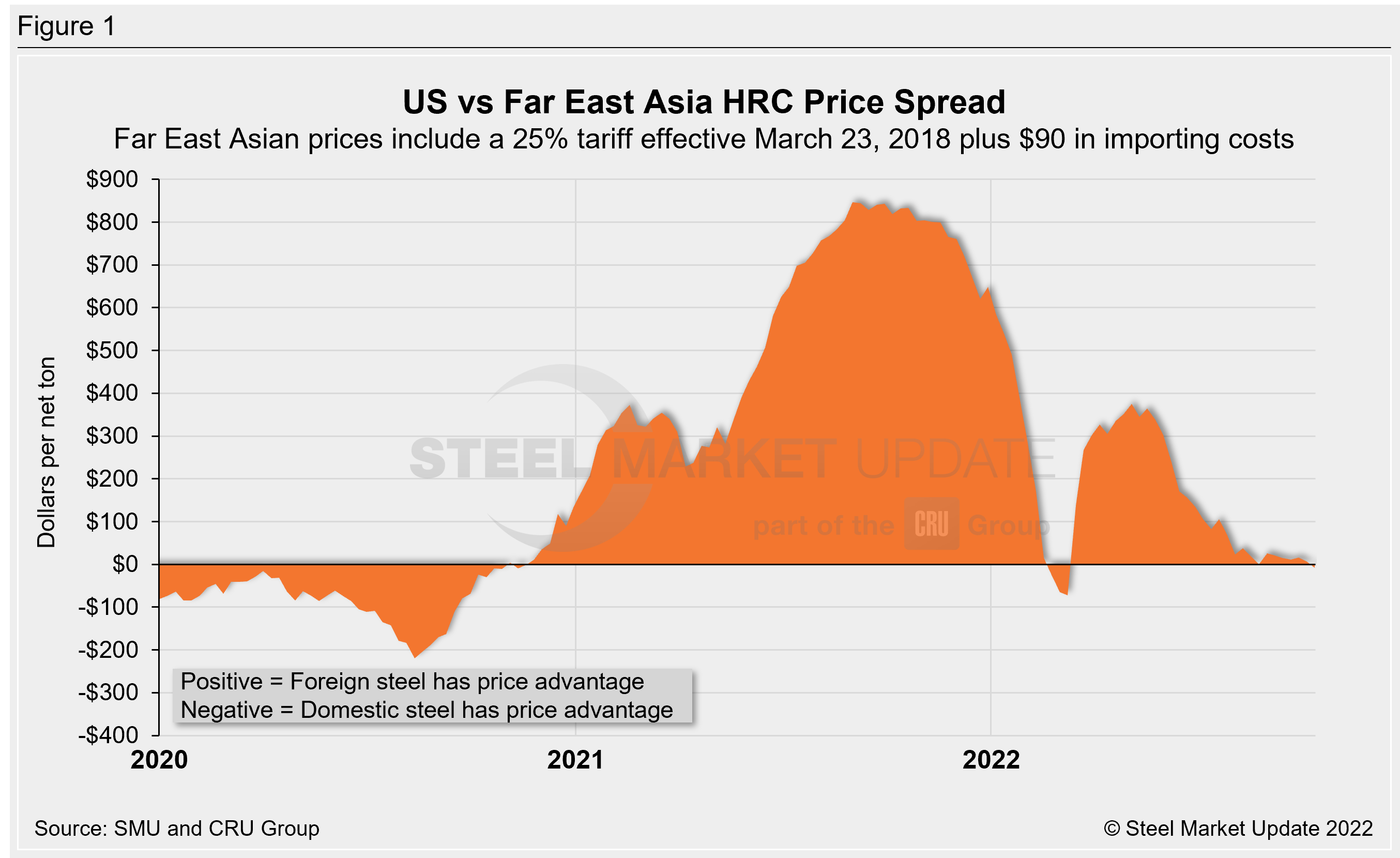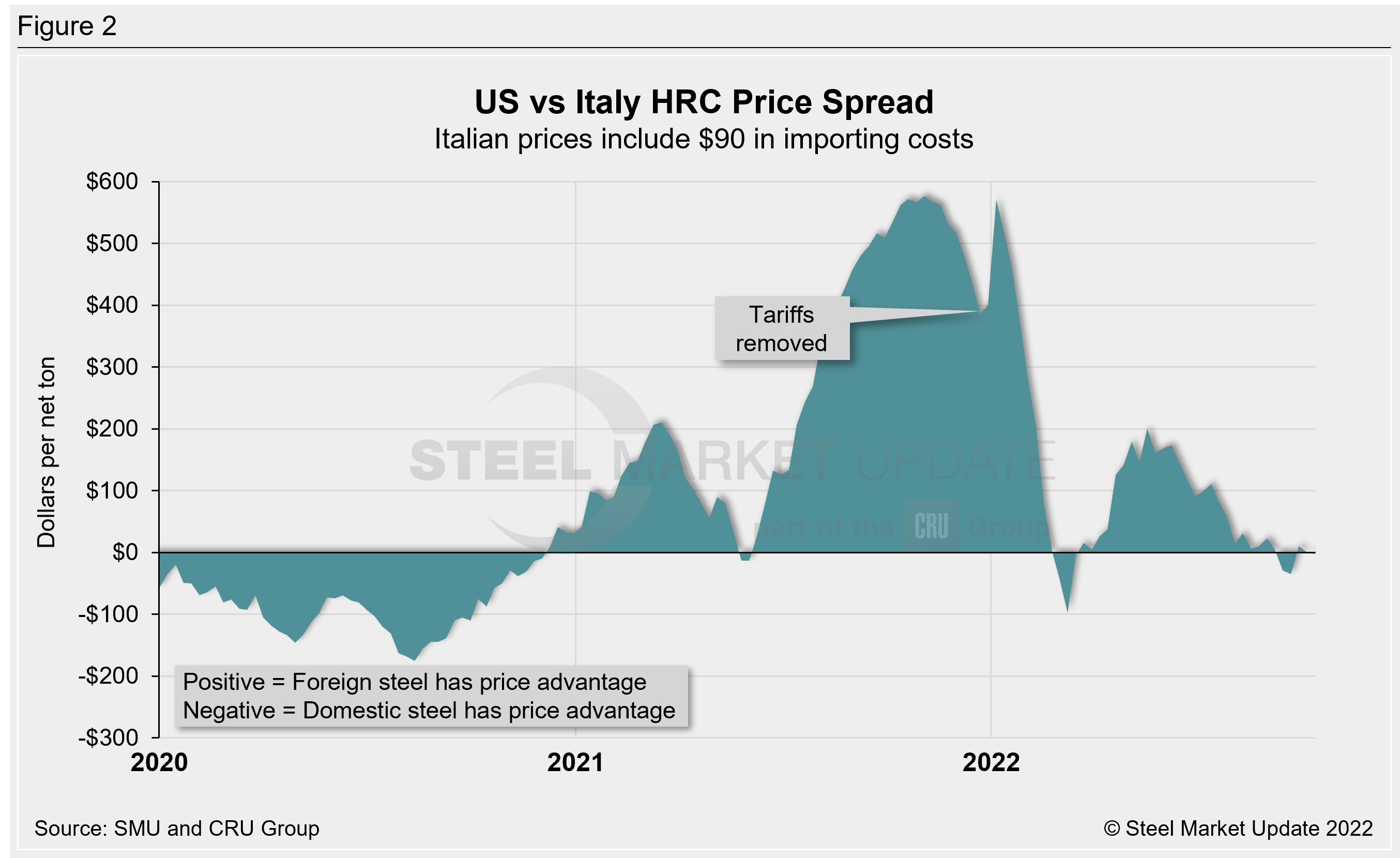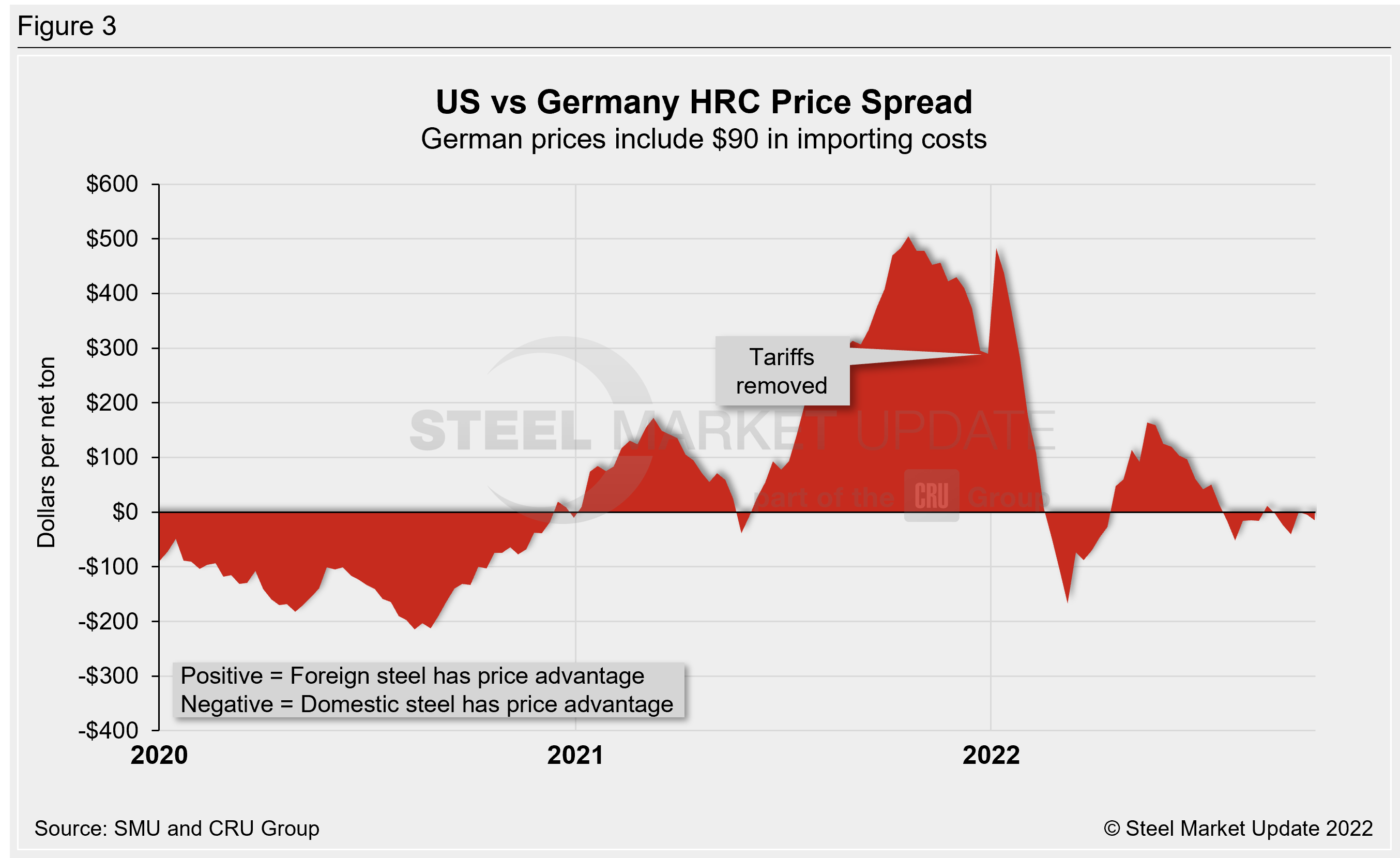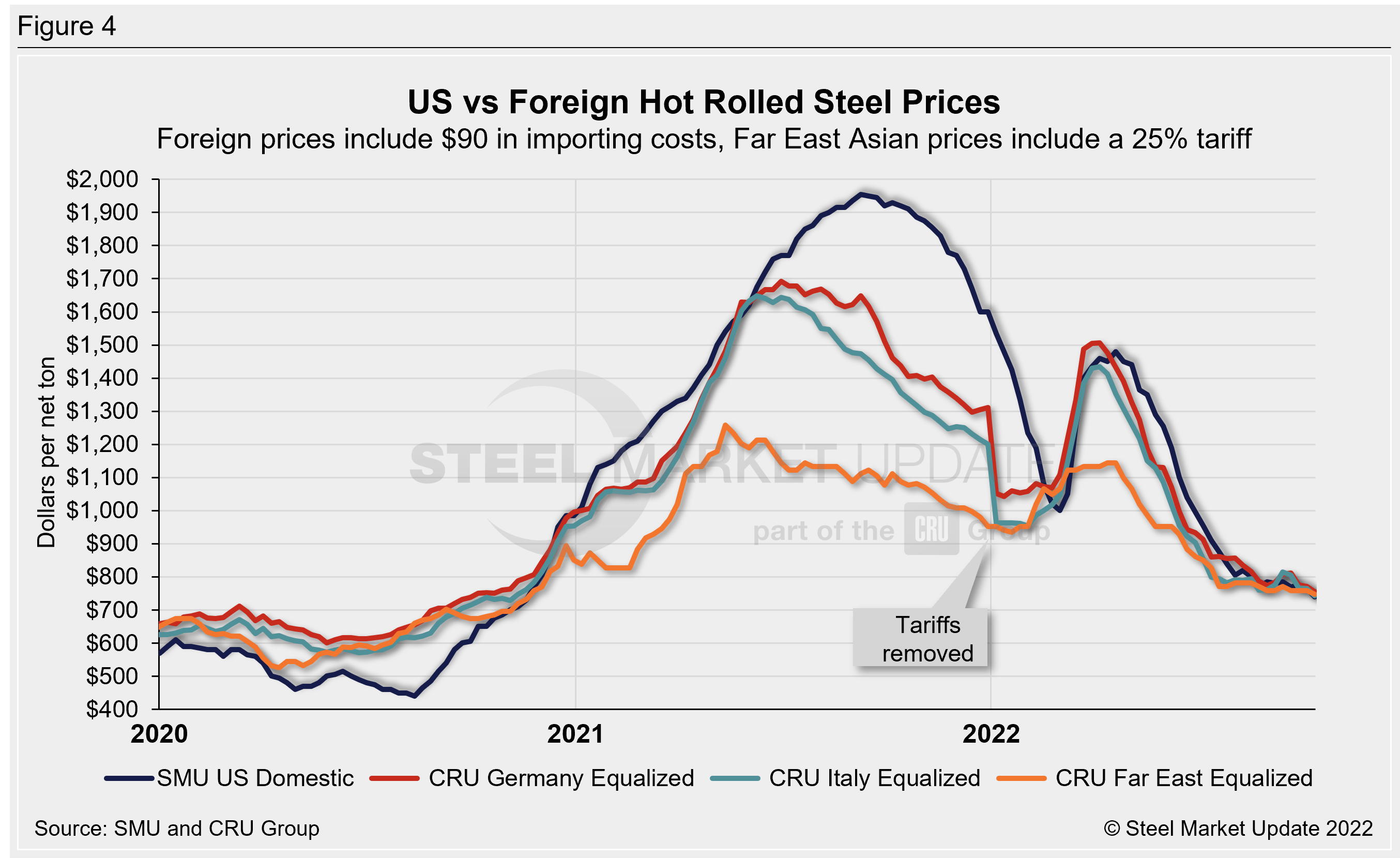International Steel Prices

Domestic HRC Prices Now Hold Advantage Over Foreign Material
Written by Brett Linton
October 13, 2022
The price advantaged once offered by foreign hot-rolled coil (HRC) over domestic steel is gone, according to Steel Market Update’s latest foreign versus domestic price analysis. Foreign prices are now higher than domestic prices after adjusting for freight costs, trader margins, and tariffs. Domestic HRC is priced as much as 2% below current foreign prices. The gap between US and foreign prices began to narrow back in May, and that trend has continued ever since.
![]() SMU uses the following calculation to identify the theoretical spread between foreign HRC prices (delivered to US ports) and domestic HRC prices (FOB domestic mills). Our analysis compares the SMU US HRC weekly index to the CRU HRC weekly indices for Germany, Italy, and Far East Asian ports. This is only a theoretical calculation because costs to import can vary greatly and often fluctuate, which influences the true market spread.
SMU uses the following calculation to identify the theoretical spread between foreign HRC prices (delivered to US ports) and domestic HRC prices (FOB domestic mills). Our analysis compares the SMU US HRC weekly index to the CRU HRC weekly indices for Germany, Italy, and Far East Asian ports. This is only a theoretical calculation because costs to import can vary greatly and often fluctuate, which influences the true market spread.
In consideration of freight costs, handling, and trader margin, we add $90 per ton to all foreign prices to provide an approximate “CIF US ports price” that can be compared against the SMU domestic HRC price. Buyers should use our $90 per ton figure as a benchmark, adjusting it as necessary based on their own shipping and handling costs. If you have experience importing foreign steel and want to share your thoughts on these costs, we welcome your insight and comments: Brett@SteelMarketUpdate.com.
Far East Asian HRC (East and Southeast Ports)
As of Wednesday, Oct. 12, the CRU Far East Asian HRC price declined $9 week-over-week to $526 per net ton ($580 per metric ton), down $18 per ton compared to one month prior. Adding a 25% tariff and $90 per ton in estimated import costs, the delivered price of Far East Asian HRC to the US is $748 per ton. The latest SMU hot-rolled average is $740 per ton, down $25 week-over-week and down $45 compared to one month ago.
Therefore, US-produced HRC is now $8 per ton cheaper than steel imported from Far East Asia. This is the first time US prices have held this advantage since March 2022 (and then they only did so for three weeks) Prior to that, November 2020 was the last time domestic prices were cheaper than Asian imports. Last week, Far East Asian prices held a potential discount of $6 per ton to domestic steel, and four weeks prior that figure was $15 per ton. The differential peaked earlier this year at $375 per ton in May. The largest price spread between the regions was $847 per ton in September 2021, when Far East Asian prices held a considerable advantage.

Italian HRC
CRU published Italian HRC prices at $652 per net ton ($719 per metric ton), down $23 per ton compared to last week, and down $72 per ton versus one month prior. After adding import costs, the delivered price of Italian HRC is approximately $742 per ton.
Domestic HRC is now theoretically $2 per ton cheaper than imported Italian HRC. This spread has bounced around since August. Last week, prices between these two regions were identical. The week before, Italian prices held a discount of $10 per ton. And four weeks ago, US steel held an advantage of $29 per ton. The highest spread this year was $200 per ton in May. Before the removal of the 25% Section 232 tariff, the November 2021 spread of $577 per ton was the largest in SMU’s data history.

German HRC
The latest CRU German HRC price decreased $15 per ton from last week to $665 per net ton ($733 per metric ton), down $54 per ton from one month ago. After adding import costs, the delivered price of German HRC is approximately $755 per ton.
Accordingly, domestic HRC is now theoretically $15 per ton cheaper than imported German HRC. Last week, domestic steel offered a potential savings of $5 per ton over German steel, down from $24 per ton one month ago. Domestic HRC has had held this price advantage for all but two weeks since late July. German HRC held the price advantage for the three months prior to that, having reached a 2022 high of $164 per ton in May. Prior to the removal of the 25% tariff, the October 2021 spread of $504 per ton was the widest in SMU’s data history.

The graph below compares all four price indices and highlights the effective date of the tariffs. Foreign prices are referred to as “equalized,” meaning they have been adjusted to include importing costs (and tariffs in some cases) for a like-for-like comparison against the US price.

Notes: Freight is an important part of the final determination on whether to import foreign steel or buy from a domestic mill supplier. Domestic prices are referenced as FOB the producing mill, while foreign prices are CIF the port (Houston, NOLA, Savannah, Los Angeles, Camden, etc.). Inland freight, from either a domestic mill or from the port, can dramatically impact the competitiveness of both domestic and foreign steel. When considering lead times, a buyer must take into consideration the momentum of pricing both domestically and in the world markets. In most circumstances, domestic steel will deliver faster than foreign steel ordered on the same day.
Effective Jan. 1, 2022, the traditional Section 232 tariff no longer applies to most imports from the European Union. It has been replaced by a tariff rate quota (TRQ). Therefore, the German and Italian price comparisons in this analysis no longer include a 25% tariff. SMU still includes the 25% S232 tariff on foreign prices from other countries. We do not include any antidumping (AD) or countervailing duties (CVD) in this analysis.
By Brett Linton, Brett@SteelMarkeUpdate.com

Brett Linton
Read more from Brett LintonLatest in International Steel Prices

Doubled S232 tariff holds US HR prices below EU
David Schollaert presents this week's analysis of hot-rolled coil prices, foreign vs. domestic.

Higher US CR prices inch closer to EU, Japanese tags
US cold-rolled (CR) coil prices continued to tick higher this week, while offshore markets were mixed.

Stacked S232 keeps US HR prices below EU
US hot-rolled coil prices crept up again this week but still trail imports from Europe.

Doubled S232 lifts EU, Japanese CR prices over US tags
US cold-rolled (CR) coil prices edged up again this week, and most offshore markets moved in the opposite direction. But the diverging price moves stateside vs. abroad did little to impact pricing trends. The bigger impact was from Section 232, which were doubled to 50% as of June 3. The higher tariffs have resulted in […]

CRU: Sheet demand remains weak, tariff changes again alter markets
Subdued demand has continued to weigh on steel sheet prices globally.
